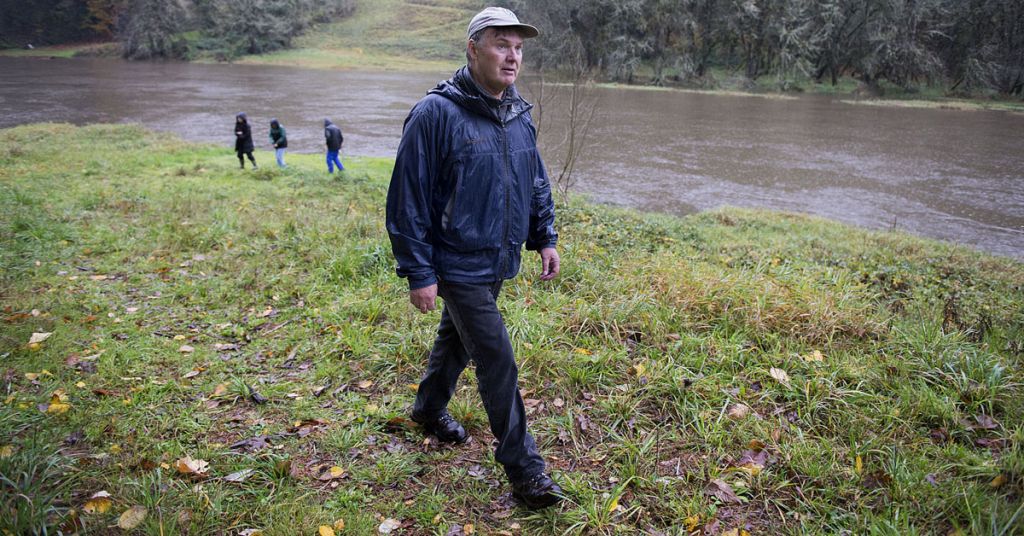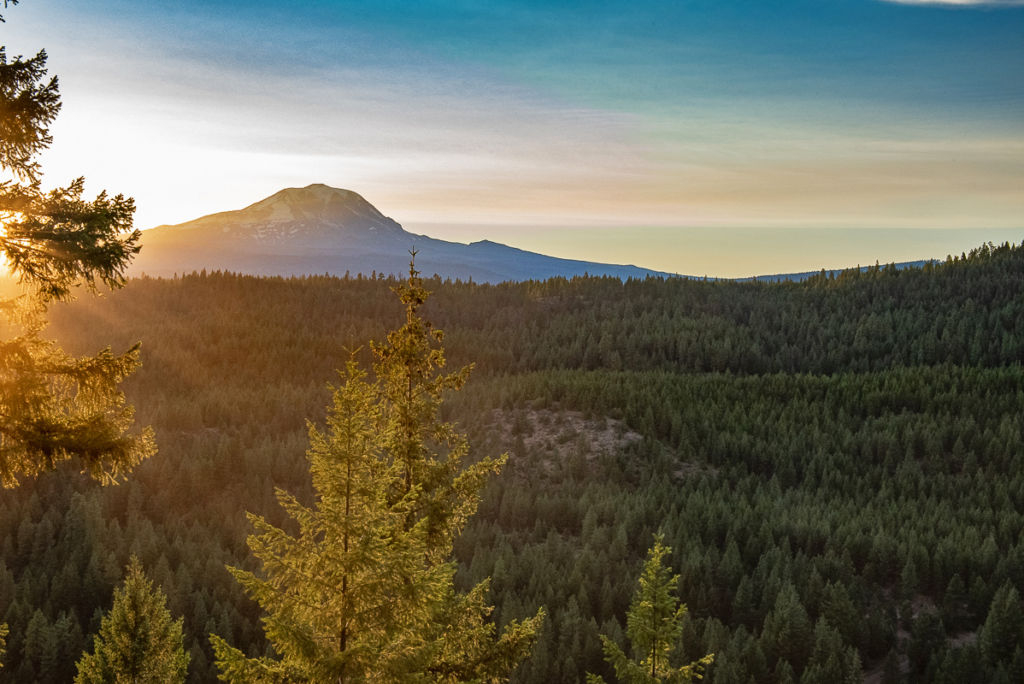Once abundant, Oregon white oak populations in the East Cascades face numerous obstacles, the legacy of fire suppression among them

Tricky shape: Identified by leaves with rounded lobes, Oregon white oaks face a perilous future. Photo: Nathan Gilles
By Nathan Gilles. July 6, 2023. The oaks stand alone on the golden-brown hills overlooking the Dillacort Creek Natural Area, not far from the Columbia River Gorge town of White Salmon, Wash. With wide, open grasses between them, the oaks’ canopies unfurl like giant green parasols.
But down here at the natural area, those green parasols are only slightly unfurled. These oaks also appear thinner.
Yet both the hillside trees and the natural area trees belong to the same species: Oregon white oak.
Oregon white oak (Quercus garryana), or Garry oak, is one of only two oak species native to the Pacific Northwest, and it’s the only native oak found this far north.
One reason Oregon white oak can live in different environments is the tree’s ability to change. And the species, like other oaks in the genus Quercus, also has a remarkable ability to foster life.
“One of my favorite things about oak trees—and I’m going to attach a label to them, a human attribute—I think they are very generous trees,” says Lindsay Cornelius, who has agreed to give me a tour of the natural area. “Oregon white oaks support a huge range of biodiversity.”
Cornelius wears hiking boots, jeans and a gray T-shirt with the words “Columbia Land Trust” on it. She works for Columbia Land Trust, a local environmental nonprofit that helps set aside natural spaces as protected lands.
It also facilitates larger conservation efforts. This is Cornelius’s job.
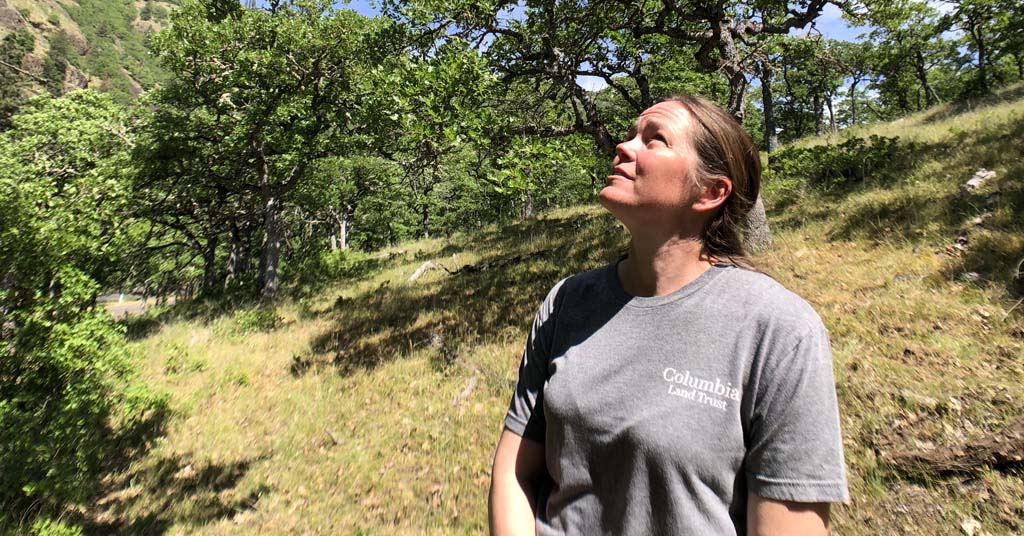
Watchful eye: Lindsay Cornelius is the East Cascades Oak Partnership’s lead at Dillacort Creek Natural Area. Photo: Nathan Gilles
Cornelius oversees the East Cascades Oak Partnership (ECOP), a multi-organization effort between Columbia Land Trust, federal and state land and wildlife managers, other nonprofit environmental organizations, local Tribes and private landowners.
These groups have been brought together by their interest in protecting Oregon white oaks and the many species they harbor in the East Cascades.
With their characteristic gray fissured bark and dark green leaves with rounded lobes, Oregon white oaks are estimated to provide food and habitat for roughly 200 different species.
These include black-tailed deer, the Lewis and Pileated woodpecker, multiple invertebrates, bats, fungi, a very rare lichen, numerous plant species and the Western gray squirrel, which is listed as a protected species in Washington and a “sensitive” species in Oregon.
Critically this list of species also includes humans.
It’s now widely acknowledged that for thousands of years, the Pacific Northwest’s original inhabitants used fire to cultivate oaks.
Now, due to a different set of human choices, Oregon white oak is in decline throughout the region. It’s a trend Cornelius and her colleagues at ECOP hope to reverse in the East Cascades.
But their efforts faces several obstacles, among them climate change, loss of habitat to Douglas fir due to fire suppression policies, how people now interact with oaks and even the East Cascades themselves.
Land of extremes
The Dillacort Creek Natural Area lays well within the Cascade Range’s rain shadow, receiving just 15 inches of precipitation annually. This is roughly half of what falls on White Salmon just 15 miles away, and a pittance of the what falls some 60 miles away in the Portland metro area.
As a consequence, the trees here are small, about 8 to 10 inches in diameter and no more than 25 feet tall; this is despite the fact that they’re all about 110 years old, according to research by Cornelius and others.
They’re a far cry from oaks that grow 36 inches wide and 80 feet tall in wetter regions west of the Cascades.
Nonetheless, Oregon white oaks clearly dominate this landscape. The only other trees in sight are ponderosa pines. And the oaks far outnumber the pines.
Regardless of oak’s extraordinary ability to withstand dry conditions, the Gorge’s extremes make managing oaks in the East Cascades extremely difficult, according to Cornelius.
“We’re trying to provide management guidance, but we don’t want to provide the same guidance for someone who is in a 40-inches-of-rain-annually oak system and someone who is operating in a 10-inches-of-rain-annually oak system,” says Cornelius.
Roughly 97% of the Willamette Valley’s oak habitat has been lost.
To figure out how best to provide that guidance, Cornelius and her colleagues undertook an extensive mapping effort, surveying oak habitat on both the Oregon and Washington sides of the Columbia River Gorge.
The total area mapped starts roughly in White Salmon in the west and ends near the Yakama Indian Reservation in the east (which also marks the East Cascades Oak Partnership northern boundary). The southern boundary is set by the Warm Springs Indian Reservation in Oregon. (Both the Yakama Nation and the Warm Springs Tribes are participating in ECOP.)
Mapping revealed that the Gorge contained not one or two but six different kinds of oak habitats.
But ECOP’s mapping showed something else—that the East Cascades contain some of the larger and more connected Oregon white oak habitat left in the Pacific Northwest.
Elsewhere, the story is far different.
Arresting the decline
Oregon white oaks grow from Vancouver Island in British Columbia south to Northern California—with small pockets found as far south as Los Angeles County.
In the Pacific Northwest, the species has seen a sharp decline since Euro-American settlement took off in the mid-1800s.
This has been especially true west of the Cascades where the vast majority of Oregon white oaks were cut down to make way for farms and cities, used as building material and firewood or were simply removed to make space for more commercially valuable and faster-growing trees.

Bark with bite: Oregon white oak bark is typically gray and fissured. Photo: Nathan Gilles
Oak habitat once covered as much as 65% of the Willamette Valley. Today roughly 97% of the valley’s oak habitat has been lost.
Oaks in the East Cascades have also been impacted by Euro-American settlement. Gorge oaks were cut down to, among other things, power the steamships that once ferried people and goods up and down the Columbia River.
However, the total impact on oak habitat in the East Cascades has been less than to the west of the Cascades. Cornelius and others at ECOP hope to keep it that way.
One potential obstacle to this goal is land ownership.
The vast majority of Oregon white oak habitat in the East Cascades is found on private land.
But according to Cornelius, this is a potential strength rather than a drawback.
“The oak partnership [ECOP] is really trying to think about conservation strategies that will work with people,” says Cornelius. “The goal is not to remove people from the landscape. The goal is to create a reciprocal relationship that can allow both to really flourish.”
As part of their efforts to preserve and restore local oak habitat, ECOP is investigating how the local landscape is being used and how to accommodate both oaks and people.
One of these uses is cattle grazing.
This is where the Dillacort Creek Natural Area comes in.
How cattle might help manage oaks
A wooden fence and an old cattle trailer mark the entrance to the natural area.
Some two decades ago, Columbia Land Trust set aside the land as a nature preserve at the request of a local rancher, a process that involved, according to Cornelius, “a thousand cups of coffee” with the former land owner in order to seal the deal.
As part of the deal, the rancher retained grazing rights on the site.
Not far away, we see them in the shade of the oaks: black cattle, their heads down chewing away.
These cattle are part of an experiment being run by Cornelius and ECOP to see if cattle can be used to browse down unwanted oaks.
“All of this was thinned,” says Cornelius, gesturing to the nearby oaks.
The thinning was designed to both lower the local fire hazard and foster the growth of an oak woodland, an oak habitat that looks and behaves differently from the oak savanna habitat found high on the surrounding hills.
“Instead of growing up, they [the oaks] grow out,” says Cornelius.
This has changed the woodland canopy and understory of the forest. As more light was allowed to reach the forest floor, the understory plants changed to more sun-loving species.

Natural habitat: Oak savanna at White Salmon Oak Natural Resources Conservation Area. Flowers include native lupine and balsamroot. Photo: Nathan Gilles
But thinning Oregon white oak isn’t easy.
Cornelius estimates roughly 50-70% of the oaks that were cut down re-sprouted, sending up shoots from their stumps.
“They have this amazing ability when you cut them down to continue going,” says Cornelius.
But, she says, the small sprouts, if allowed to grow, presented a fire hazard.
They needed to be cut down, but this would require hours of labor.
Prescribed burning was out of the question. The site, like many others in the Gorge can get windy. So, Cornelius and colleagues hit on another strategy: they’d use the cattle.
The cattle are strategically penned in to encourage them to eat the oak sprouts. So far, Cornelius says, the strategy is working.
The evidence can be seen dotting the landscape.
Bushy green patches of browsed but still growing oak stumps are everywhere, growing next to yarrow, wild parsley and poison oak.
Cornelius isn’t the only ECOP member investigating the use of cattle to manage oak habitat.
A similar effort is also starting at Oregon’s White River Wildlife Area, according to Chase Brown who manages the wildlife area for the Oregon Department of Fish and Wildlife.
“The re-sprouting of oaks in just a few years can turn into a giant fuel hazard,” says Brown. “And the only way we can address that is either by herbicide application or very heavy manual labor or using it as grazing opportunity.”
Getting back to their roots
Oregon white oak’s ability to regrow is connected to a trait common among oaks of multiple species: their extensive and deep root systems.
This makes the trees extremely resistant to both drought and fire, according to Dave Peter, a retired researcher at the U.S. Forest Service’s Pacific Northwest Research.
“Along comes a fire and burns the top [of a seedling]. Now if you’re a Doug fir or a pine, that’s the end of the story, but not with an oak,” says Peter. “Oaks invest heavily underground. This gives them a tremendous advantage when it comes to drought and fire.”
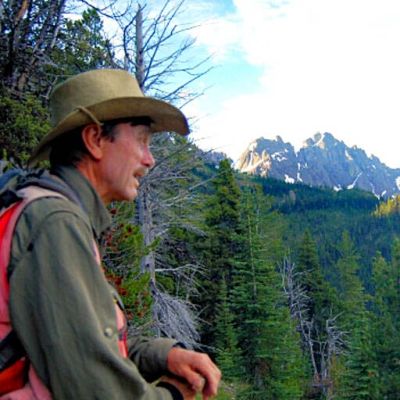
Dave Peter. Photo: USFS
Peter is an Oregon white oak enthusiast. He’s written numerous studies on multiple aspects of the species, including its remarkable resistance to fire.
He says full-grown oaks are even more resistant to fire than seedlings.
In a 2011 paper in the journal Trees, Peter published the results of a multiple-year study on mature oaks and fire.
The study was conducted at Joint Base Lewis-McChord, west of the Cascades and south of Tacoma, Wash.
The military base contains the largest intact oak habitat in Washington.
The study found that the buds of oak leaves have an incredible ability to resist heat.
“The trees can lose their leaves and basically shrug it off. If the buds are alive, they’re going to pop out next spring and you will have a new crop of leaves,” says Peter.
Fire suppression policies, however, have tended to favor conifers, especially Douglas fir.
This has had consequences for oaks.
Douglas fir encroachment
After meeting with Cornelius, I head west past White Salmon and further up in elevation to the Weldon Wagon Trail, a former wagon trail that now includes the White Salmon Oak Natural Resources Conservation Area.
Annual precipitation here is about 31 inches. Compared to Dillacort Creek, it feels almost humid. The vegetation is notably different.
The entrance to the conservation area is surrounded by Douglas firs. It’s dark in the woodland.
After a short walk, I see my first oaks.
The trees are tall with broad stretching canopies, suggesting they initially grew in a much different environment.
On closer inspection, I see that while many of their branches have green leaves, many others are nearly black. They appear dead.
It’s easy to see why. Their sunlight is being blocked by the firs.
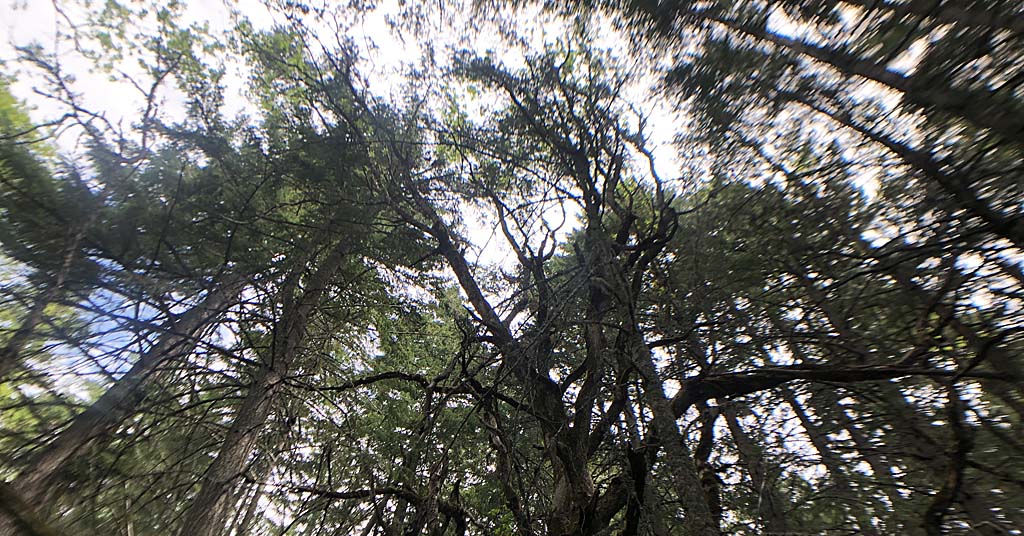
Growing problem: Douglas fir encroaching on oak at White Salmon Oak Natural Resources Conservation Area. Photo: Nathan Gilles
Owned and maintained by the Washington Department of Natural Resources, the conservation area is the site of a recent effort to free oaks from Douglas fir encroachment.
I find these recently freed trees further along the trail.
They have the same open configuration as the other oaks with a similar number of dead-looking branches, but these trees are bathed in sunlight. The nearby light-blocking firs have been cut down.
The major reason Doug firs have encroached on this oak habitat is fire suppression, says ECOP member Keyna Bugner, who oversees the management of the site for Washington DNR.
“We excluded fire from these areas, and that didn’t keep the conifers down as much,” says Bugner. “Once they [conifers] get big enough, they start overtopping the oaks.”
The conservation area isn’t unique. ECOP estimates that as much as 60% of the East Cascade’s oaks are currently at risk of conifer encroachment.
Bugner says one of the obstacles to her work is the shortage of region-specific information on oaks.
“And that’s kind of what we’re running into in how we manage the oaks in the East Cascades. There’s a lot we’re still figuring out,” says Bugner.
One of the big unknowns is how often the area was intentionally burned by local Tribes.
How Tribes managed oaks
West of the Cascades, the evidence for the use of prescribed burning by Tribes—sometimes called “cultural” or “anthropogenic” fire—is “pretty solid,” according to Peter.
One of the principle reasons Tribes burned in this wet climate was to encourage oak habitat by eliminating the more competitive conifers.
“Oak will never grow as fast or as tall as any of the conifers,” says Peter. “So, without tipping the balance—and I’m sure the native peoples all knew this—without tipping the balance in their [oaks’] favor, you’re going to lose them. It’s just a matter of time.”
This point is illustrated in Peter’s 2006 study in the journal Restoration Ecology.
The paper focuses on Oregon white oak habitat in the southeastern portion of Washington’s Olympic Peninsula. The study estimates the region’s current maritime climate developed around 4,500 years ago.
As the paper notes, the local climate favors conifers, including hemlocks, cedars and Douglas fir. It goes on to argue that without fire, oaks in the landscape would have been overtopped and overshadowed.
But, of course, the environment wasn’t left to its own devices, it was burned by the Skokomish, or Twana Tribe, to encourage the oaks and the first foods they provide, a process Peter says was akin to orcharding.
Similar research has been conducted on the cultural fire practices of other Pacific Northwest indigenous peoples, including the Kalapuya, the original inhabitants of Oregon’s Willamette Valley.
However, says Peter, the evidence for cultural fire in the East Cascades is not as strong, because the region is drier and burning probably wasn’t needed as often.
But there’s an exception, according to Peter, the region’s wetter western edge, areas like the Weldon Wagon Trail.
This is essentially what a 2019 study published in the journal Forest Ecology and Management found.
The study compiled information on cultural fire provided by Tribal elders from the Confederated Tribes of the Warm Springs. The Tribes’ traditional lands include sections of the East Cascades.
The study notes that the Tribes’ wetter western lands were burned to encourage first foods, mostly huckleberries. The study doesn’t mention Oregon white oaks.
However, Brigette McConville, a member of the Confederated Tribes of Warm Springs and a former Tribal Council Representative and anthropologist for the Tribes, says her people burned to encourage oaks. (McConville is a member of the Columbia Insight Board of Directors.)
McConville isn’t involved in ECOP, though the Confederated Tribes of Warm Springs are. The person leading the effort for the Tribes couldn’t be reached for a comment.
McConville says when she was a child, her grandmother made her a sweet acorn porridge. To make the naturally bitter acorns palatable, her grandmother would first leach out their tannins before grinding the acorns in an ornate bowl made from an oak burl, or irregular growth, cut off from a living tree.
But, says McConville, oaks and acorns don’t play the role they once did.
“There’s not that many people who gather acorns anymore,” says McConville.
In 1996, McConville and others conducted a series of interviews with Tribal elders. Topics discussed included using fire to cultivate first foods, including acorns. She asked the elders how often they intentionally burned the land.
“It was always stated,” McConville remembers, “‘when it was needed.’ But it was never like ‘every year’ or ‘every other year.’ We were never told that.”
McConville say she suspects that part of the reason for this ambiguous answer is that in the absence of fire suppression, the drier sections of the East Cascades burned frequently enough that cultural burning wasn’t needed or wasn’t needed often.
She also suspects that a lot of cultural knowledge about burning has been lost, noting that the oldest elder she interviewed was in her late 90s at the time and had not practiced or witnessed cultural burning, but had only heard of the practice from her elders.

Elaine Harvey: Incorporating traditional knowledge. Photo: Courtesy of Elaine Harvey
Biologist Elaine Harvey, Yakama Nation Fisheries environmental coordinator, says the Confederated Tribes and Bands of the Yakama Nation also used fire to encourage oak habitat.
“Burning was essential as a land management tool,” says Harvey. “A lot of our first foods are linked with fire.”
Harvey, who is a member of the Yakama Nation’s Kamiltpah Band, is currently working with Cornelius and ECOP.
In 2006, she and others at the Yakama Nation interviewed Tribal elders about past land management practices, including burning. Like McConville and Peter, she says cultural burning in the East Cascades probably wasn’t as extensive as it was west of the Cascades because in the absence of fire suppression the land burned naturally.
She says this information, often called “traditional ecological knowledge,” has since been incorporated into the Yakama Nation’s forestry programs.
She’s hoping to do something similar with ECOP.
“Having these partnerships, like the East Cascade Oak Partnership, is important because we can bring that traditional ecological knowledge to the management of lands,” says Harvey.
However, Harvey says, she’s concerned about how Oregon white oaks will fare under future climate change.
“Right now, our watershed is snowpack, and in the climate change forecasts we are expecting more transition to rain [as the climate continues warming],” says Harvey. “I think since the oaks are in a transition zone they will be more sensitive to climate change. I think there are going to be impacts to the oaks and their future distribution.”
In 2019, the Yakama Nation published its Climate Action Plan. The plan lists Oregon white oak as a species of “high concern” under climate change; this despite the tree’s well-known drought tolerance.
One reason cited is the tree’s reliance on animals, including birds and squirrels, to disperse its seeds.
This could limit the tree’s ability to migrate to more suitable habitat as the climate shifts.
Relying on “evolutionary memory”
Due to its well known drought-tolerance, Oregon white oak is often predicted to do well as the climate warms.
For instance, a 2012 study published in the journal Environmental Management predicts the tree’s growing range, or climatic niche—where the tree can now grow based on temperature and precipitation—is likely to expand in the decades ahead as the climate warms.
The study even predicts an expansion of the tree’s climatic niche in the dry East Cascades.
But these predictions have critics. Peter is one of them.
Peter says some of the more optimistic predictions for Oregon white oak probably aren’t modeling the true complexity of the tree’s physiology.
For instance, he says, the Pacific Northwest has a “Mediterranean climate,” meaning it has wet winters and dry summers. And oaks didn’t evolve in a Mediterranean climate.
“Oaks tend to grow in monsoonal type climates, where you get precipitation in the summer,” says Peter. “Wherever you get a Mediterranean climate you lose the diversity of oaks tremendously. You lose productivity. And you find that the oaks that are there are kind of in high gear evolutionarily, trying to adapt to this not-typical habitat for oaks.
“Oregon white oaks are no exception. It still has its evolutionary memory of wanting lots of moisture in the hot, dry summer.”
This is one reason he says oaks in the East Cascades will never grow as tall or as wide or produce as many acorns as the trees do west of the Cascades.
In fact, he says, while Oregon white oak dominates the East Cascades’ drier sites, acting as a “climax” species, the species is already at or near the limits of what it can tolerate climatically. Climate change, he says, is likely to push trees past that limit.
“I think if you consider that those oaks in that climax zone are barely hanging on as it is, if it gets warmers and drier, they’re gone,” says Peter.
East Cascades advantage
Peter isn’t the only scientist skeptical of optimistic predictions.
A 2015 paper published in the journal Climatic Change ranked the vulnerability of 11 Pacific Northwest native trees species to climate change.
The study examined each species’ current climatic niche then projected how those niches will shift in the future due to climate change.
Like other climate predictions, this process used computer models, but it didn’t use a model to do the actual ranking. That was done by tree experts, local scientists with decades of experience observing and studying the region’s trees.
The experts determined that Oregon white oak was likely to experience the greatest impacts from climate change.
Mirroring comments made Peter, the study notes that Oregon white oak already “occupies some of the driest low woodland and savanna sites from British Columbia to California …” and this is increasing the species’ vulnerability to climate change.
“With some of these drought tolerant species like [Oregon white oak], I think that there are some thresholds that we may be coming close to or maybe even have exceeded in some environments that exceed their ability to tolerant those extreme conditions,” says study lead author Michael Case, forest ecologist at the environmental nonprofit Nature Conservancy, and an affiliate associate professor at the University of Washington.
“So, there are some ecological thresholds, some tipping points if you will, that we may be approaching,” says Case.
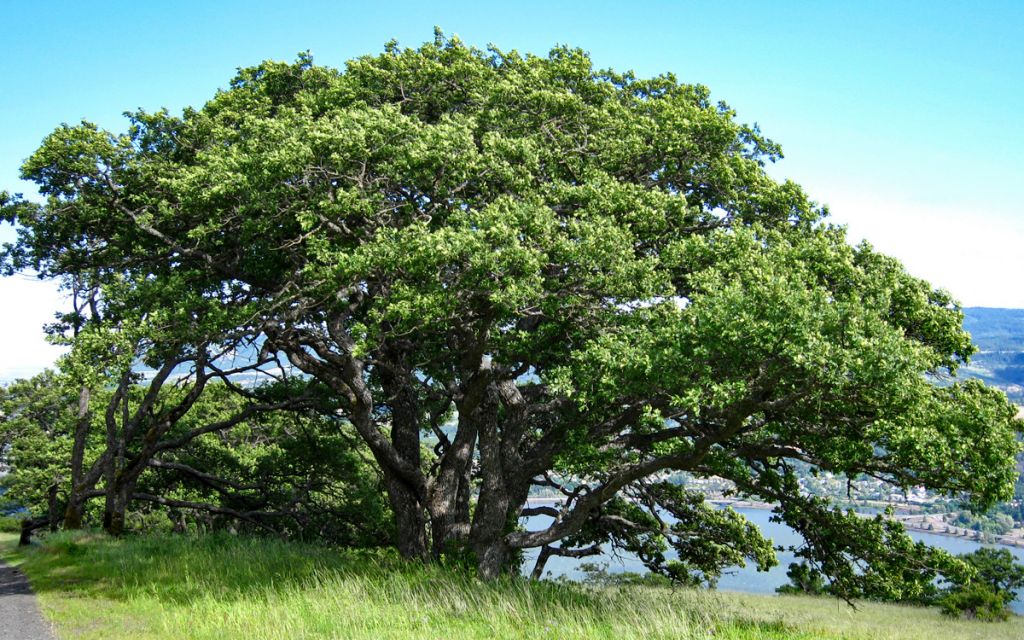
Shady acres: A member of the beech family, Oregon white oak is one of only four deciduous oaks native to the West Coast. Photo: Jurgenhessphotography
The experts involved in the study also flagged oak’s reliance on animals to disperse its seeds as a factor likely to increase its vulnerability to climate change.
Critically, the study’s experts also flagged land use changes, particularly population growth and human development in places like the Willamette Valley as a factor.
Both factors are expected to limit Oregon white oak’s ability to migrate to more suitable habitats.
This is where Cornelius says the East Cascades, for all its disadvantages, has one major advantage over other oak habitats: it still has connected lands.
Back at the Dillacort Creek Natural Area, Cornelius shows me a very different section of the preserve.
I see the same green patches of still-growing oak stumps lining the woodland floor, but here the trees are even thinner and shorter.
The trees here are far more exposed to the sun. It’s another example of the East Cascade’s climate extremes, what Cornelius calls the region’s “steep climate gradients.”
But where others might see an obstacle to preservation in the face of climate change, Cornelius sees an advantage.
“As climate conditions change, these really steep gradients—going from 40 inches of [precipitation] to 10 across 40 miles—species might not have to move quite as far because the gradients are really steep,” says Cornelius.
The key, she says, will be maintaining the connection between those different habitats. Something she says she’s hopeful that efforts like ECOP will help.
“Oaks have a fighting chance if we can maintain connectivity across those gradients,” says Cornelius. “That’s an encouraging feature of the East Cascades.”
Columbia Insight’s reporting on biodiversity in the Columbia River Gorge is supported by the Autzen Foundation and Pacific Power Foundation.





